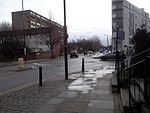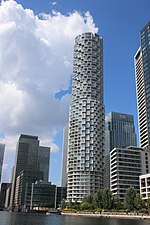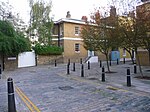Isle of Dogs Pumping Station
Grade II* listed buildings in the London Borough of Tower HamletsInfrastructure completed in 1988Postmodern architecture in the United KingdomPumping stationsUse British English from June 2024

The Isle of Dogs Pumping Station, nicknamed the Temple of Storms, is a pumping station located on the Isle of Dogs, London. It was designed by John Outram under commission from Edward Hollamby of the London Docklands Development Corporation and completed in 1988. It removes excess rainwater collected on the development's Enterprise Zone and overflow from the nearby Manchester Road sewers. The station was granted grade II* heritage status by Historic England in 2017 during a campaign for greater representation of post-modern architecture on the register.
Excerpt from the Wikipedia article Isle of Dogs Pumping Station (License: CC BY-SA 3.0, Authors, Images).Isle of Dogs Pumping Station
Folly Wall, London Blackwall
Geographical coordinates (GPS) Address Nearby Places Show on map
Geographical coordinates (GPS)
| Latitude | Longitude |
|---|---|
| N 51.499333333333 ° | E -0.0079166666666667 ° |
Address
Folly Wall 1
E14 3YH London, Blackwall
England, United Kingdom
Open on Google Maps









